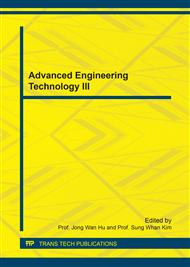p.599
p.605
p.612
p.619
p.624
p.630
p.636
p.645
p.650
Establishment of Gas Chromatography Analytical Method for 4-Amino-2-Methylpentane
Abstract:
The aim of this paper was to establish a gas chromatography (GC) method for the determination of 4-amino-2-methylpentane and validate the methodology. The gas chromatography conditions such as column temperature, carrier gas flow rate, split ratio and the make-up gas flow rate were investigated in detail. The chromatographic column used in this method was capillary column of DA-1. The oven temperature was initially held at 40 °C for 15 min and was then programmed temperature to 140 °C at the rate of 75 °C/min and held for 10 min. The injection temperature was 180 °C and the flame ionization detector temperature was 200 °C. The carrier gas was high pure nitrogen with a flow rate of 0.8 mL/min. The split ratio was 130:1 and the make-up gas flow rate was 30 mL/min. Good linearity of 4-amino-2-methylpentane was obtained within the concentration range of 25.44 mg/mL to 84.81 mg/mL and the correlation coefficient was 0.9990. Good accuracy and precision were obtained and the average recovery was 101.76%. The quantification limit of 4-amino-2-methylpentane was 7.21 μg/mL and the detection limit of that was 3.72 μg/mL. The method was well-validated and proved to be used for quality test of 4-amino-2-methylpentane.
Info:
Periodical:
Pages:
624-629
Citation:
Online since:
June 2017
Authors:
Keywords:
Price:
Сopyright:
© 2017 Trans Tech Publications Ltd. All Rights Reserved
Share:
Citation:


